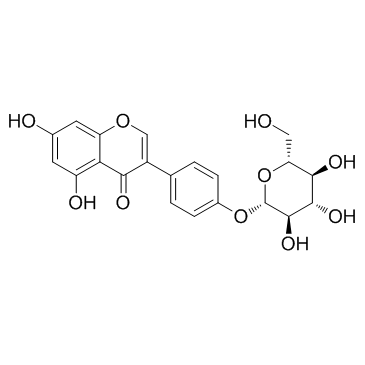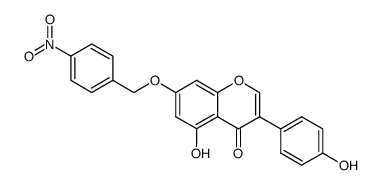152-95-4
| Name | Sophoricoside |
|---|---|
| Synonyms |
4-(5,7-Dihydroxy-4-oxo-4H-chromen-3-yl)phenyl β-D-glucopyranoside
Genistein-4'-glucoside 4H-1-Benzopyran-4-one, 3-[4-(β-D-glucopyranosyloxy)phenyl]-5,7-dihydroxy- Genistein 4'-Glucoside 4'-(β-D-Glucopyranosyloxy)-5,7-dihydroxyisoflavone 4H-1-Benzopyran-4-one,3-[4-( 4',5,7-Trihydroxyisoflavone-4'-D-glucoside MFCD01075138 Sophoricoside 3-[4-(b-D-Glucopyranosyloxy)phenyl]-5,7-dihydroxy-411-1-benzopyran-4-one |
| Description | Sophoricoside is an isoflavone glycoside isolated from Sophora japonica and has anti-inflammatory, anti-cancer and immunosuppressive effects. |
|---|---|
| Related Catalog | |
| In Vitro | Sophoricoside is an isoflavone glycoside isolated from Sophora japonica and has anti-inflammatory, anti-cancer and immunosuppressive effects. The results show that Sophoricoside (50 μM) significantly inhibits the PMACI-induced histamine release. The inhibition rate reaches up to 30.24%. The maximal rates of TNF-α, IL-8 and IL-6 inhibition by Sophoricoside (50 μM) are approximately 31.42%, 43.43% and 34.24%, respectively. The rates of the levels of Rel/p65 inhibition in nuclear by Sophoricoside (50 μM) is approximately 50.14%. Results show that the enhanced caspase-1 activity induced by PMACI is significantly reduced by Sophoricoside in a dose-dependent manner[1]. |
| In Vivo | When the Sophoricoside is orally administered 1 h before compound 48/80 injections, the scratching behaviors is reduced. The inhibition rate of Sophoricoside (2 mg/kg) is approximately 41.21%. Orally administered Sophoricoside inhibits the scratching behaviors by 47.31%. When mice are treated for 2 weeks with Sophoricoside, the atopic dermatitis is recovered to a significant extent[1]. |
| Kinase Assay | Cells are incubated with the Sophoricoside for 1 h, and then incubated with PMACI for 2 h. The reaction is stopped by cooling the tubes in ice. The cells are separated from the released histamine by centrifugation at 400×g for 5 min at 4°C. The histamine levels are measured by ELISA using a histamine assay kit according to the manufacturer’s directions. Duplicate aliquots of supernatant are measured for each sample[1]. |
| Cell Assay | To test the cell viability by each concentration of Sophoricoside, the MTT colorimetric assay is performed. Briefly, HMC-1 cells (3×105 cells/well) are incubated with Sophoricoside (1 to 50 μM) for 12 h. After the addition of MTT solution, the cells are incubated at 37°C for 4 h. The crystallized MTT (formazan) is dissolved in dimethyl sulfoxide and the absorbance is measured at 540 nm[1]. |
| Animal Admin | BALB/c mice (5 weeks, 19 to 20 g) are used in this study. The dorsal skin of the BALB/c mice (n=6) is shaved and treated with a depilatory prior to the experiment. The mice are sensitized with 100 μL of 0.15% DNCB in acetone-olive oil (3:1) applied to the dorsal skin twice per week for 5 weeks. Control mice receive vehicle (acetone/olive oil=3:1). After 3 weeks, Sophoricoside (2 mg/kg) is orally administered 2 weeks until the end of the experiment[1]. |
| References |
| Density | 1.6±0.1 g/cm3 |
|---|---|
| Boiling Point | 763.3±60.0 °C at 760 mmHg |
| Melting Point | 285ºC |
| Molecular Formula | C21H20O10 |
| Molecular Weight | 432.378 |
| Flash Point | 271.5±26.4 °C |
| Exact Mass | 432.105652 |
| PSA | 170.05000 |
| LogP | 0.31 |
| Vapour Pressure | 0.0±2.7 mmHg at 25°C |
| Index of Refraction | 1.717 |
| Hazard Codes | T,C |
|---|---|
| Risk Phrases | R23/24/25:Toxic by inhalation, in contact with skin and if swallowed . R36/37/38:Irritating to eyes, respiratory system and skin . |
| Safety Phrases | S26-S36-S45-S24/25 |
| RIDADR | UN 3276 6.1/PG 3 |
| WGK Germany | 3 |
| RTECS | AL7970000 |
| Packaging Group | II |
| Hazard Class | 8 |
|
~% 
152-95-4 |
| Literature: Acta Chimica Academiae Scientiarum Hungaricae, , vol. 4, p. 383,384, 386 |
|
~% 
152-95-4 |
| Literature: Acta Chimica Academiae Scientiarum Hungaricae, , vol. 4, p. 383,384, 386 |
| Precursor 2 | |
|---|---|
| DownStream 3 | |




![[4-(5,7-diacetyloxy-4-oxochromen-3-yl)phenyl] acetate structure](https://image.chemsrc.com/caspic/359/5995-97-1.png)